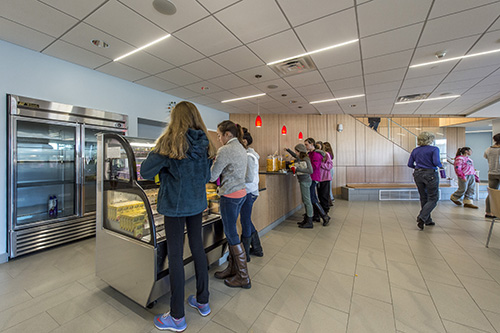- Who We Are
-
Our Work
-
Educational
- Brooks School- George and Evanthea Demoulas Family Boathouse
- Riverbend School - Gym and Schoolhouse
- Lesley University- Animation Studio
- Middlesex School- Bass Arts Pavilion and Danoff Visual Arts Center
- Nashoba Brooks School- Sureau Family Discovery Barn
- The Southport School- Arts and Music Building
- Senior Living
- Hospitality
-
Healthcare
- Partners Urgent Care
- Yale New Haven Health- Medical Office Building
- The Hospital of Central Connecticut - Advanced Wound and Hyperbaric Medicine Center
- Connecticut Children's - Infusion Center and Gastrointestinal Clinic
- Connecticut Children's - Specialty Care Center
- MidState Medical Center- Post-Anesthesia Care Unit Expansion & Renovation
- Commercial
- Specialty Work
-
Educational
- How We Do It
- Our Blog
- Industry Tidbits
- Join Our Family
- Contact Us
Technology's Impact on Lighting Systems
December 30th, 2015
LEDs offer the potential for cutting general lighting energy use almost in half by 2030.
Technology is changing at a lightening pace these days affecting everything from how we work to how we live. Even the construction industry, known for its slow adoption of change, can’t resist this movement.
One area of the A/E/C industry where technology is having a drastic impact is lighting systems. Not so long ago, you’d buy a light fixture, install it, then run the electrical line to it and you’re done. It’s no longer that simple.
Why LED?
It’s true LED lighting systems are more expensive up front, but their maintenance costs over time are significantly less. With 50,000 hours of burn time, the LED bulbs rarely need changing. (If you keep a light on for 12 hours a day, the bulb should last 11 years. Cut that down to 8 hours a day and it will last 17 years.) Compare this to 1,500 hours for an incandescent bulb and 10,000 hours for a CFL. You will save money on light bulbs and labor costs to replace the bulbs, plus there is much less disruption to the users of the space.
Lighting accounts for 18% of energy use in commercial buildings, second only to HVAC consumption, according to the Center for Climate and Energy Solutions. Cutting energy use from lighting in half also provides significant cost savings.
Other Advantages of LED
Aside from lower overall maintenance costs and energy use, LEDs have other advantages including compact size, resistance to breakage and vibration, good performance in cold temperatures, lack of infrared or ultraviolet emissions, and instant-on performance.
Proprietary Systems – Recent Experience
We completed two projects this summer that used LED lighting systems and each system was quite different. As technology is integrated more and more throughout a building, the specifications for systems are becoming more proprietary. This means there is less competition on pricing and fewer installers who can do the work.
Lighting Built into Structural Elements
We recently installed a lighting system that takes advantage of the fact that LED technology allows us to integrate light into already existing structural elements. The T-BAR LED Smartlight is a minimalistic linear lighting fixture that takes the place of a 2' or 4' cross member of the ceiling grid. This allows the lighting to become a part of the ceiling assembly, reducing building materials and saving energy.
Commissioning Required
Some lighting systems require commissioning before they can be used. We recently installed a system in a 48-bed dormitory where low voltage cables ran from a transformer box to each fixture. The lumen output of each bulb depended on the physical distance from the transformer. A commissioning agent from the lighting supplier came in and adjusted the voltage to each cable at the transformer box to ensure the proper lumen output.
This process adds time onto the schedule during the start up phase. In this particular case, the lighting supplier was located in California, so the commissioning agent needed to travel across the country. It was important to schedule the commissioning with the supplier well in advance, so the project wasn’t held up waiting for the commissioning agent.
Summary
There are many LED lighting products that will meet your needs. Some are as easy to install as the traditional light bulbs and fixtures they replace. The more complicated the system gets, the more proprietary the specifications will be. While LED lighting costs more up front than other types of bulbs and fixtures, the significantly longer lifespan and reduced energy usage will save you money in the long run.
Contact us to learn how we can help you with your next construction project.









